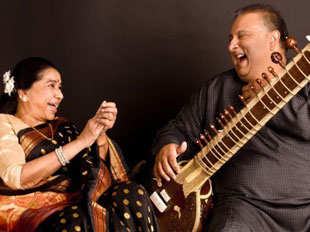![]() ‘It was one of the greatest experiences of my life – we’d throw little vocal challenges at each other, and this game of one-upmanship resulted in some beautiful vocal renditions. We are really proud of the results. I wish people could see how much fun we had.’
‘It was one of the greatest experiences of my life – we’d throw little vocal challenges at each other, and this game of one-upmanship resulted in some beautiful vocal renditions. We are really proud of the results. I wish people could see how much fun we had.’
You couldn’t ask for a better commendation for live studio recording. But how many of today’s recording studios are able to support a live session?
The quote comes from start Indian singer and sitar player Shujaat Khan, talking about the recent Naina Lagaike album made with Bollywood playback queen Asha Bhostle in my recent Old Ways, New Days blog. The sessions involved singers and band improvising song arrangements, while the studio engineers ran the multitracks – recording like it used to be.Along with some of the enthusiasm shown by the likes of Kaiser Chiefs for the BBC’s Sgt Pepper – It Was 40 Years Ago Today recording sessions, which were run in a similar way, I wondered if this suggested a return to live studio recording to accompany the revival of big-room studios.
Certainly, the two studios involved here – London’s renowned Abbey Road and India’s largest music recording company, Saregama – would be hoping so. ‘The album [Naina Lagaike] is a unique recording, and may start a trend of artists recording live in the studio,’ agrees Atul Churamani, VP of Saregama India.
Fast thinking
A return to the big room there might be. But raising the question prompted quick and worthy comment from a couple of particularly well placed voices...
Greg’s passion is live location recording and he’s a master at getting everything down in a single take. But being limited to what he can carry into the Himalayas often limits the ambition – if not the quality – of his recording. ‘Whatever the case, I am quite certain that the studios leading the way will have versatile recording spaces,’ he says. ‘That seems to be what is missing in most project studios.’
The second voice was that of Philip Newell, career studio designer and long-time champion of old school recording techniques and standards. While happy to see new studios offering large recording spaces and well-calibrated monitoring, he is fearful that the popularity of project rooms has come at the cost of the expertise required to handle live recordings with large numbers of mics – assuming the studio has the gear to support them.
‘A lot of studios force bands to record in a way that the studio can accommodate, rather than allowing a band to record in the way they have written and rehearsed their songs,’ Newell argues. ‘It’s not what musicians want.’
He’s absolutely right.
Wide ranging
For a start, the cost of high-quality mic preamps and AD converters means that a studio may build up a collection of different preamps to partner its mics, each with their own distinct character. This is fine if they are used specifically for these qualities, or when multitrack overdubbing allows the same mic-preamp-coverter combinations to be used repeatedly (giving an especially close match between tracks). But it doesn’t pan out so well if the preamps on drum overheads or a three-mic piano set-up are of different breeds, no matter how good they may be. And a string ensemble?

With all the gear in place, a good-sounding live room is essential if musicians are going to feel comfortable enough to give their best performance – a point well made by Phil Newell: ‘I’ve completed a number of larger studios in Spain, and the guys can’t believe their luck when they can all play together. They have become so used to having to lay time code and then building up a recording by overdubbing. That’s fine for some music but the interplay between the musicians disappears.’
This, of course, makes the ultimate demand on the recording engineer. The luxury of concentrating on one element of a session at a time is gone – everything has to be set up and put to tape together. Everything from the drum mics to the level on the lead vocal (unless we are going to entertain a limited amout of overdubbing) has to be under control.
This is a world away from the average project studio, where recordings are ‘constructed’ rather than ‘captured’, and the skills involved are a world away from a live session.
Not that the result should be perfect – we can readily accept performance mistakes and small failings in a recording as part of the ‘performance’. Classic albums from all genres of music are loved warts ’n’ all. Sometimes the warts help make them great.
I’d wager Greg is absolutely right about the new place big-room studios have in commercial recording. And I’d wager the money and minds behind them have this sussed too. But what about Phil? Are today’s big rooms equipped to handle live recording? Have we been away from old school recording long enough to be facing a period of re-learning? (If we are, the internet is not the place to go…)
So, if we are serious about this – and we had better be – then we need to insure our faith in old school recording with old school experience and advice. Listen well.

